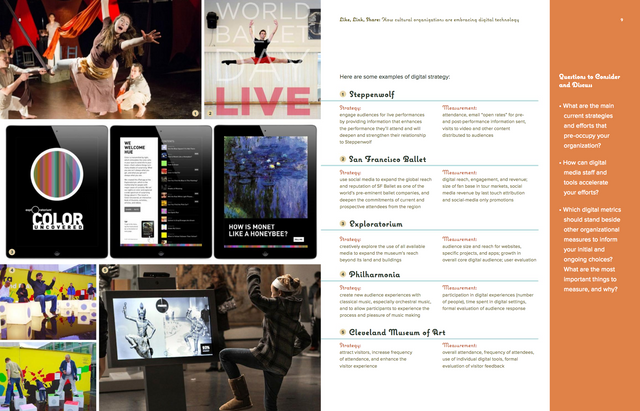"Build Capabilities Not Projects"
The Wyncote Foundation’s 2014 report, Link, Link, Share, outlines strategies on how cultural institutions can use digital technologies to extend their missions. The report states,
“...as institutions become more adept with digital technologies and interactive modes of audience engagement, they are reaching more people, learning new ways to engage substantively with audiences, and opening their physical doors to the public. Digital innovation is sparking not only ‘cool new projects’ but also fundamental changes in the orientation of legacy institutions toward a more spirited public presence and a renewed sense of civic purpose.” (pg. 5)
 Like, Link, Share: How Cultural Institutions are Embracing Digital Technology, (Commissioned by the Wyncote Foundation: November 1914).
Like, Link, Share: How Cultural Institutions are Embracing Digital Technology, (Commissioned by the Wyncote Foundation: November 1914). An institution’s digital identity is, in my opinion, its most important and impactful marketing tool. New digital tools and technologies have made access to information and resources quicker and easier than ever before, but that convenience has increased audience expectations. Practically every organization I get introduced to comes via social media, and prior to any site visit, I browse the organization’s website and digital content to determine its value. Institutions must use their digital identity to stake their claim in a crowded landscape and make their presence known.
Ideally, this could level the playing field and allow smaller institutions to reach broader audiences, but maintaining a digital infrastructure requires additional time and resources. A robust digital strategy introduces new demands, and smaller institutions already lack the time and workforce to complete their immediate tasks like administration, education, preservation, outreach, etc.
Although much of the conversation surrounding digital strategy revolves around the individual institutions, I think there is still greater potential for organizations to collaborate and build a stronger cultural ecosystem. The report discusses the necessary collaborative nature of digital work, but it focuses more on internal dynamics. What if we witnessed cross-organizational collaboration more frequently? Nearly every archive and research library has a digital content management system, and they assign their content with detailed metadata including Library of Congress subject headings. This generates a controlled vocabulary and makes research easier. What if there was a similar function that encouraged resource discoverability within a geographic region?
For example, what if someone was exploring a digital collection from the Library Company of Philadelphia and there was an immediate hyperlink to a similar collection at Temple's Special Collections? In return, Temple could then suggest the Library Company's collection and perhaps something from the Historical Society of Pennsylvania or Drexel. This digital collaboration could lead to stronger partnerships and a healthier interconnected system for research.
100% of the SBD rewards from this #explore1918 post will support the Philadelphia History Initiative @phillyhistory. This crypto-experiment conducted by graduate courses at Temple University's Center for Public History and MLA Program, is exploring history and empowering education. Click here to learn more.
Yes! Connectedness is only step one. Interconnectedness would be a meaningful measure of successful digital strategy.